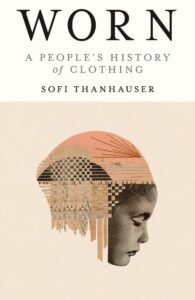SDA Book Club: “Worn” reviewed by Faith Hagenhofer
August 5, 2022
Worn: A People’s History of Clothing by Sofi Thanhauser
Organized by fiber type, Worn is absolutely a history of clothing, but to be more precise, a history of its manufacture, and the labor therein. These intersections allow Thanhauser to explore firsthand this attribute of being human—our need for clothing and what it means for those who labor to make the raw materials—then thread, cloth and finally garments. We learn about linen, cotton, silk, a variety of synthetics and wool, and the effects of clothing production on the earth. Global in scope, broadly historical Thanhauser is exploring the path of:
“how we went from making fabric for ourselves as part of our everyday work to dressing in clothes that come from a complex, inscrutable system that has divorced us from the creative act, from our land, from our rights as consumers and workers.” (p.xiii)

She writes mostly about women. Women who grow, weave, sew; women who are exploited, as virtual and actual slaves; women who successfully organize for better conditions and women for whom the better conditions of their work never arrive, despite their enormous efforts; women who warn the regulators of the degree of toxicity in the various fiber growing conditions and in the making of synthetic fibers. These warnings have a dubious effect on the clothing that fills stores today. Thanhauser’s research has taken her both around the world and doubtless into many archives. And thus she writes the detailed stories of those who make what we wear.
As she explores the stories of technological and chemical innovation the mechanics of modernity emerge, and with it a history of capitalism through the lens of this commodity. Indeed we can say that she follows the “worn” path to global manufacture which dominates the markets today. At one point it struck me that “worn” might refer to the condition of modern makers of our cheap clothing—they are worn out!
As a shepherd it was a joy to come to the section on wool, placed last in the book. Thanhauser addresses wool much less historically, which works, partly because much has already been written about this ancient animal/human partnership. She writes with great hope about wool work today and tomorrow:
“Spinners, knitters, weavers, felters, and other wool enthusiasts who have increasingly turned to the pleasures of the handmade in the 20th century are not merely returning to older models of craft. They are engaged in the critical work of helping preserve the diversity of sheep (my emphasis)”…
…who we now know can play a critical role in the carbon sequestration system. Worn is thought provoking and a hugely satisfying read, a book I will return to for its precise prose and information.
–Faith Hagenhofer
- Publisher: Pantheon (buy it here)
- Date: January 2022
- ISBN: 9781524748395
If you’ve read this book, leave a comment and let us know what you think!
Do you have a recommendation for a recent fiber-related book you think should be included in SDA’s Book Club? Email SDA’s Managing Editor, Lauren Sinner, to let her know!

1 Comment
Gillian Moss says
August 5, 2022 at 7:31 am
I’m sure this is a very interesting and informative read and I wish you all the best with it. I hope Holly Chastain, the artist whose work is on the cover will be recognized - after all it is paper weaving.